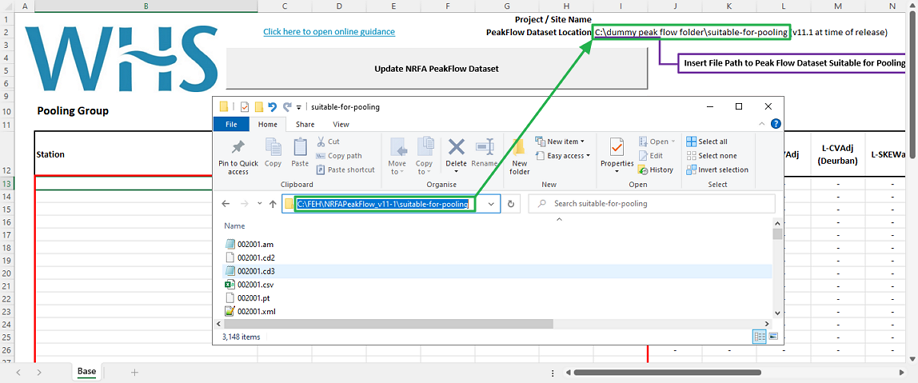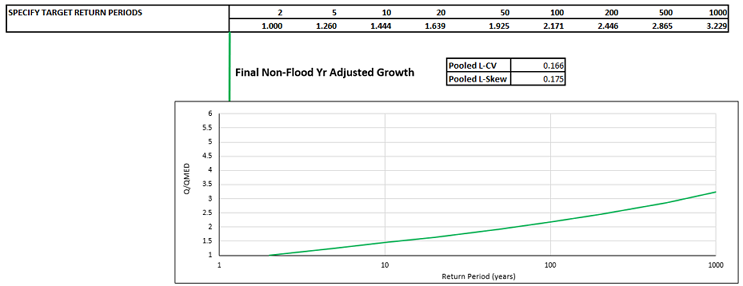The WHS Non-Flood Years Adjustment Spreadsheet applies the non-flood years adjustment procedure within the FEH statistical methodology to provide WINFAP 5 users with non-flood years adjusted growth curves for use in peak flow assessments.
The methods used are those described in FEH Volume 3, previously known as 'Permeable Adjustment'. Within the report 'Review of flood frequency estimation in groundwater dominated catchments' (EA, 2022) it was noted that catchments with a high proportion of non-flood years tend to be those which have a low rainfall (SAAR) and are not restricted to permeable catchments. The WHS Non-Flood Years Adjustment Spreadsheet will allow adjustments for all catchments that have non-flood years and is compatible with outputs from WINFAP 5, being able to utilise both observed and deurbanised L-moments. Note that the spreadsheet does not use the Enhanced Single Site estimation method; no additional weight will be given to the target station if it is included in the pooling group.
The WHS Non-Flood Years Adjustment Spreadsheet is available as a free download from the WHS Website.
The spreadsheet includes a macro which allows it to be updated with each new release of the NRFA Peak Flow dataset. This is currently compatible up to an including version 13.02.
This guidance provides details on:
- using the macro to update the NRFA Peak Flow dataset in the spreadsheet, and
- the steps required to derive a non-flood years adjusted growth curve.
To optimise the performance of the fitting algorithm it is recommended that the default formula tolerance settings are amended within Excel. This can be completed through the following process: File --> Options --> Formulas. In 'Calculation Options' we recommend setting 'Maximum Iterations' to 200 and 'Maximum Change' to 10-10.
Updating the NRFA Peak Flow Dataset
-
Open the non-flood year adjustment spreadsheet and navigate to the Base tab where you will see a macro button and instruction to insert a filepath into cell I2.
-
Navigate to where the Peak Flow Dataset is saved on your computer. The dataset should have three folders; select the Suitable for Pooling folder and copy the full filepath into cell I2.

- Once the filepath has been copied run the macro by clicking the Update NRFA Peak Flow Dataset button. This will derive a non flood year adjusted L-Skew value and L-CV value (and deurbanised adjusted value) for all of the Suitable for Pooling gauging stations with non-flood years present in their records. The flow chart below provides a summary of the actions carried out by the macro.
-
Once the macro has run through which can take a few minutes, the adjusted L-CV and L-Skew values (and adjusted deurbanised values) will be stored ready for application of the non-flood year adjustment procedure for your target catchment.
-
The spreadsheet is now ready to use. You will not have to run the macro again until the next Peak Flow Dataset is released.
Deriving a non-flood years adjusted growth curve
-
Paste your accepted pooling group into the red box starting in Cell B13 in the Base tab. Specifically, copy the eight data fields under the AM data table of the Pooled and QMED dashboard.
-
Fill in cell C37 with the URBEXT2000 value for your target catchment to calculate URBAN in cell C36. Alternatively, fill in cell C36 with the URBAN parameter for your target catchment, this is listed under the Edit Urbanisation Method in the Pooled & QMED Dashboard in WINFAP.
-
The formulas in the Base tab will have automatically extracted the non-flood years adjusted L-CV and L-Skew values (and adjusted deurbanised values) for pooling members with non-flood years present in their records.
-
Check the Warnings column (R13-R33), the table below details the list of potential warnings and the recommended actions for each.
| Warning Message | Description | Action |
|---|---|---|
| BFIHOST19 >=0.65 | BFIHOST19 is more than or equal to 0.65. This indicates a permeable catchment which may be a reason for non-flood yrs being present in the station record. | No action required |
| SAAR <=800 | SAAR is less than or equal to 800mm. This indicates a dry catchment which may be a reason for non-flood yrs being present in the station record. | No action required |
| Non-Flood yrs over 15% of record, station review recommended | Non-flood yr adjustment applied, but more than 15% of the record comprised of non-flood yrs. | This may indicate a non-standard catchment response to rainfall, which may be significantly different to your target catchment. Consideration should be given to removing the station from the pooling group. |
| Adjusted L-skew is negative consider removing station | Following non-flood yr adjustment the L-Skew value for the station has become negative. | A negative L-skew value indicates that the GL distribution is bounded. Consideration should be given to removing the station from the pooling group. |
-
You can select whether to deurbanise the L-moments for the pooling groups stations in cell C39. By default the L-moments should be deurbanised with 'Yes' selected. More guidance on when to applying the deurbanisation procedures is available in the Urbanisation Procedures.
-
Having reviewed the warnings and selected whether to deurbanise L-moments, you should now be able to extract the non-flood years adjusted growth curve. The non-flood years adjusted growth curve for your target catchment is provided in cells C42-K42 along with the associated pooled L-CV and L-Skew values in cells H45 and H46 respectively. This can be used to re-scale your derived QMED value yielding non-flood years adjusted flows. Note the default return periods in cells C41-L41 can be edited to give you growth factors for alternative return periods.
